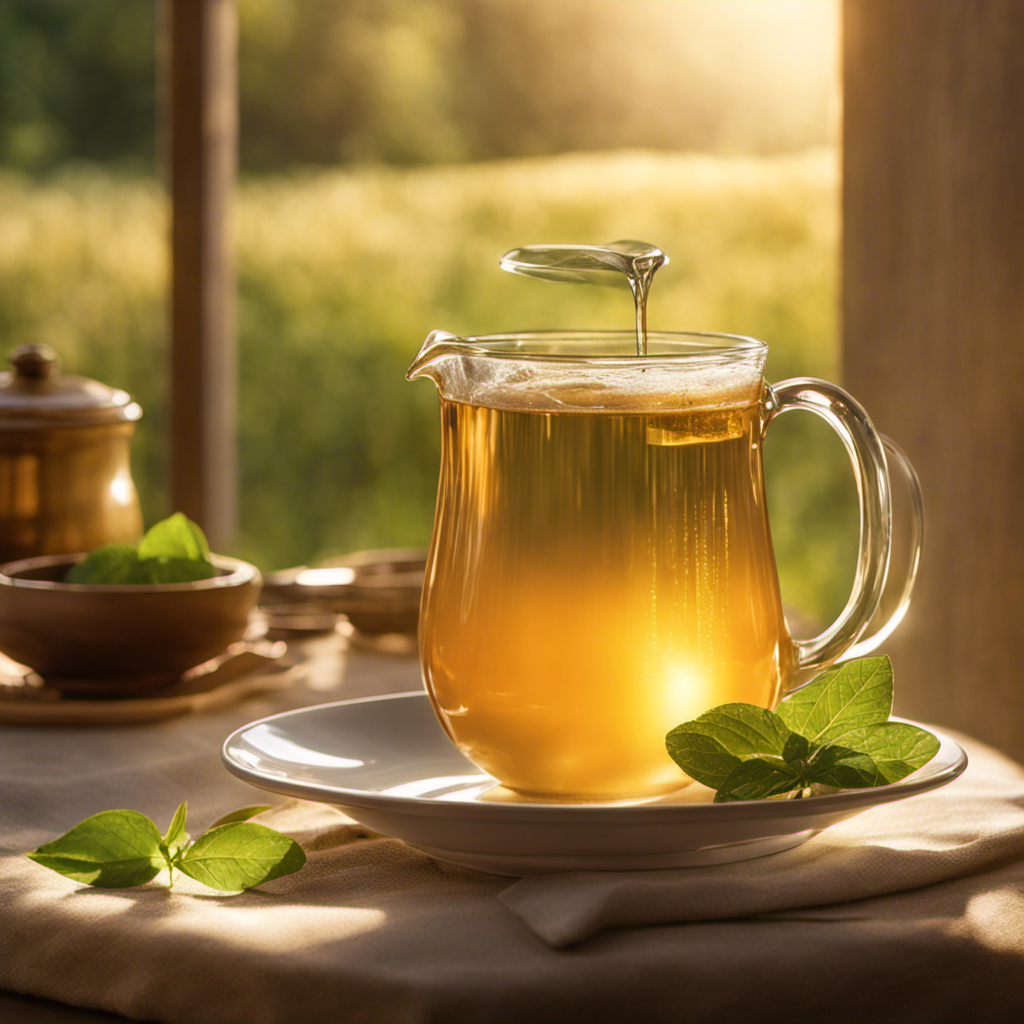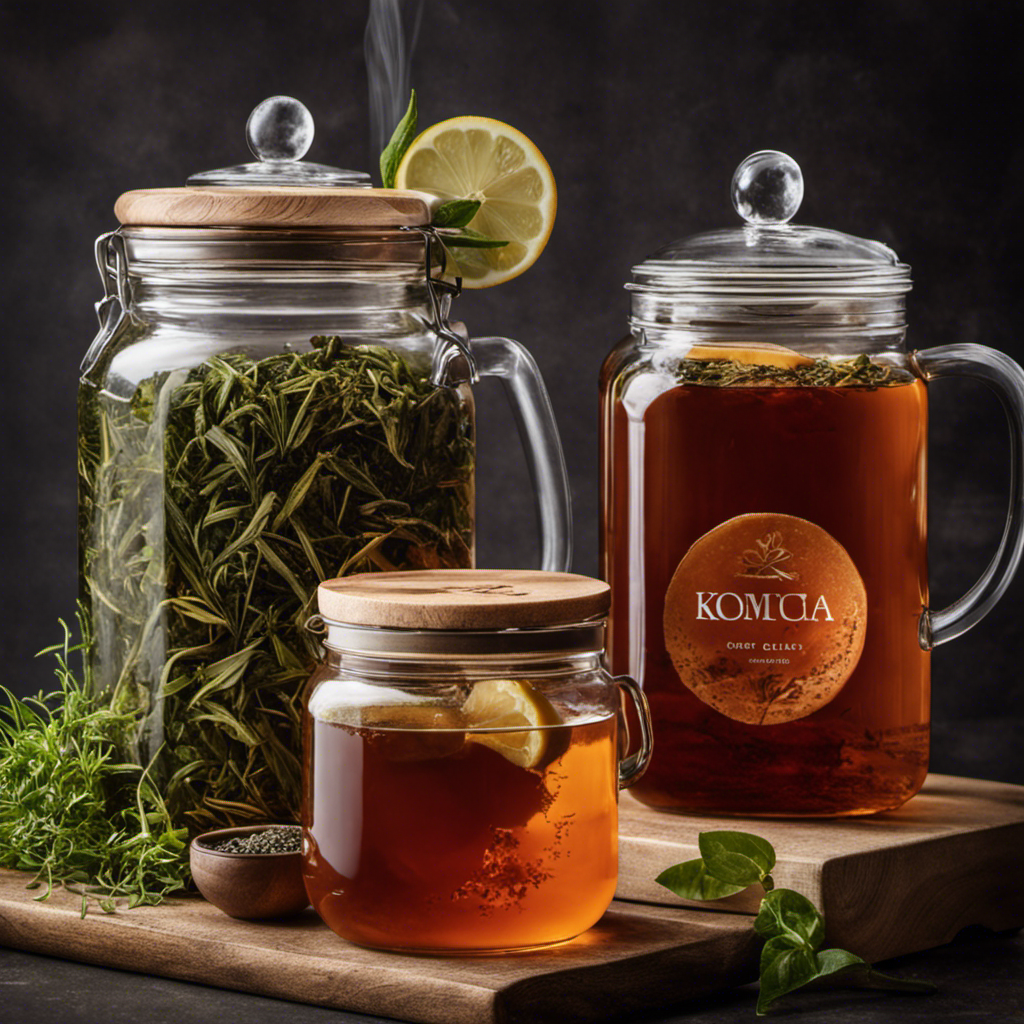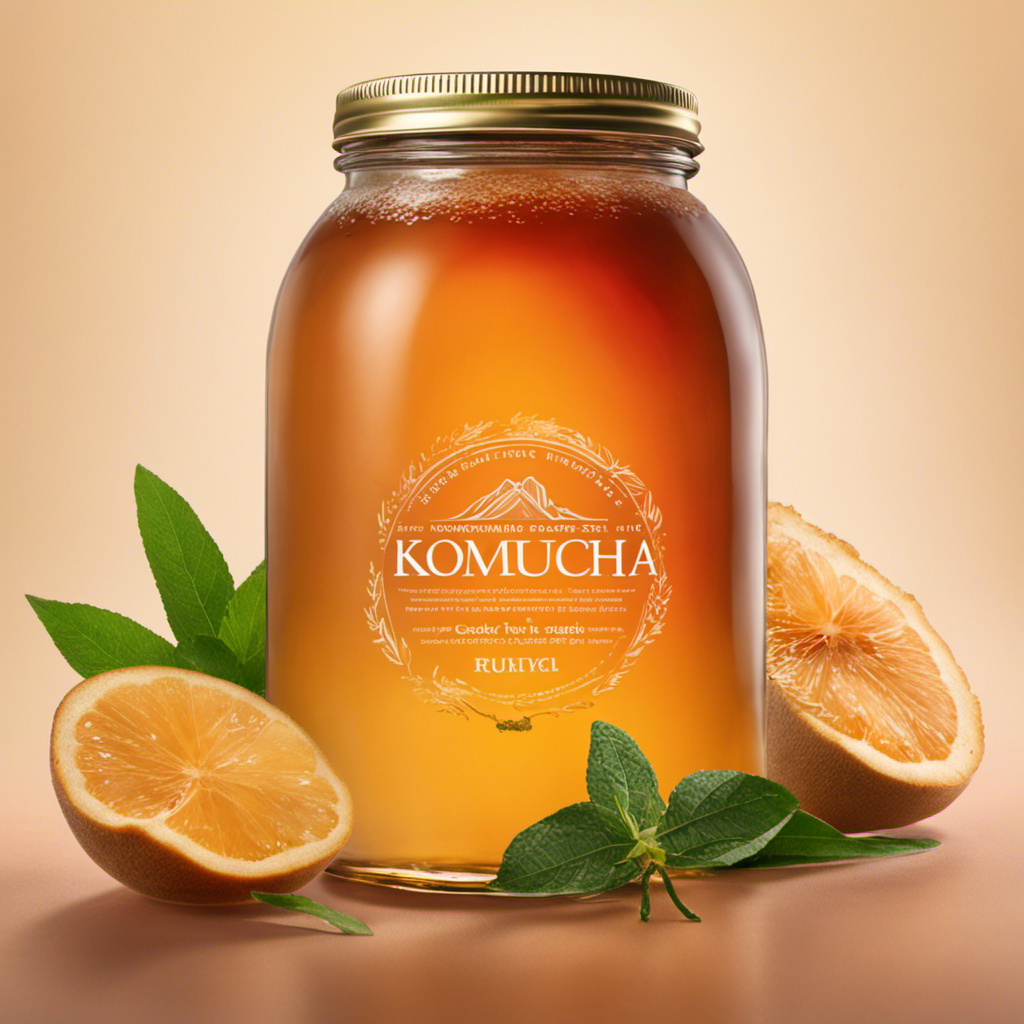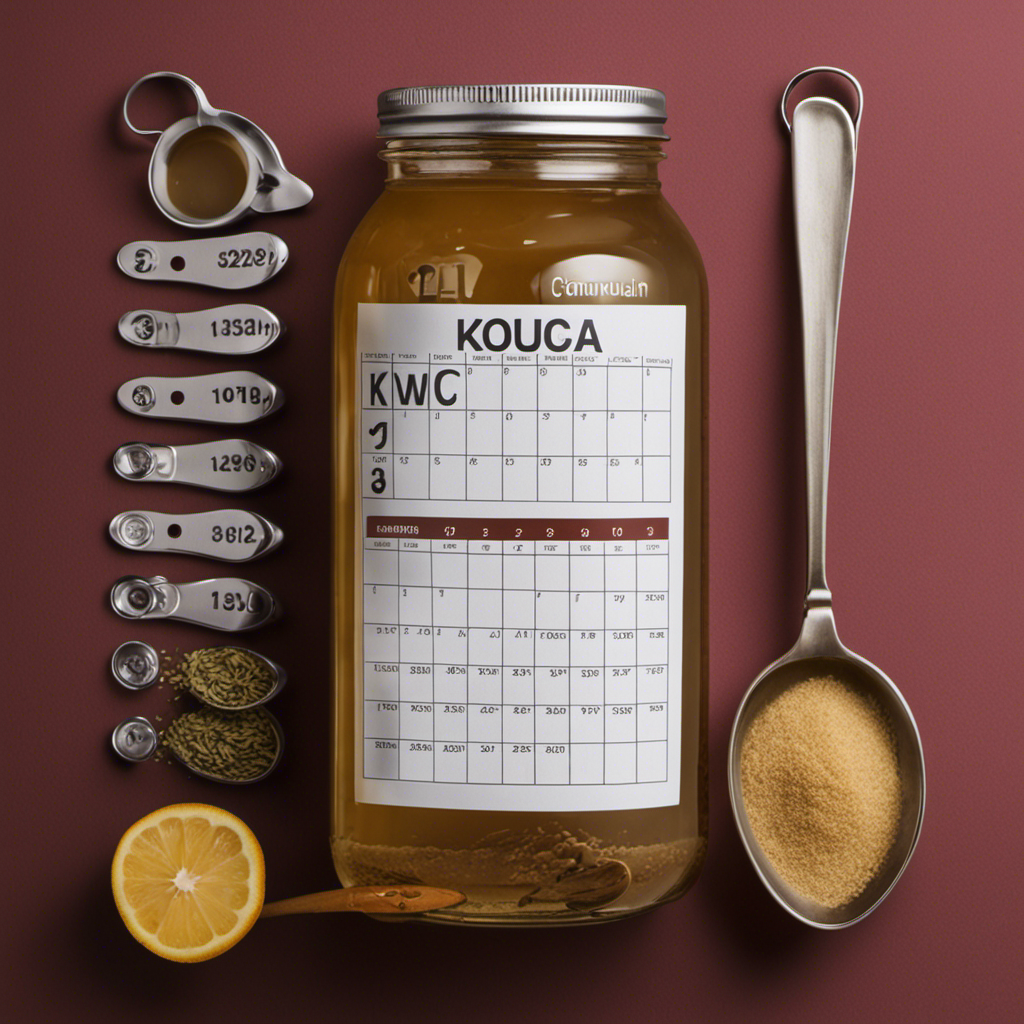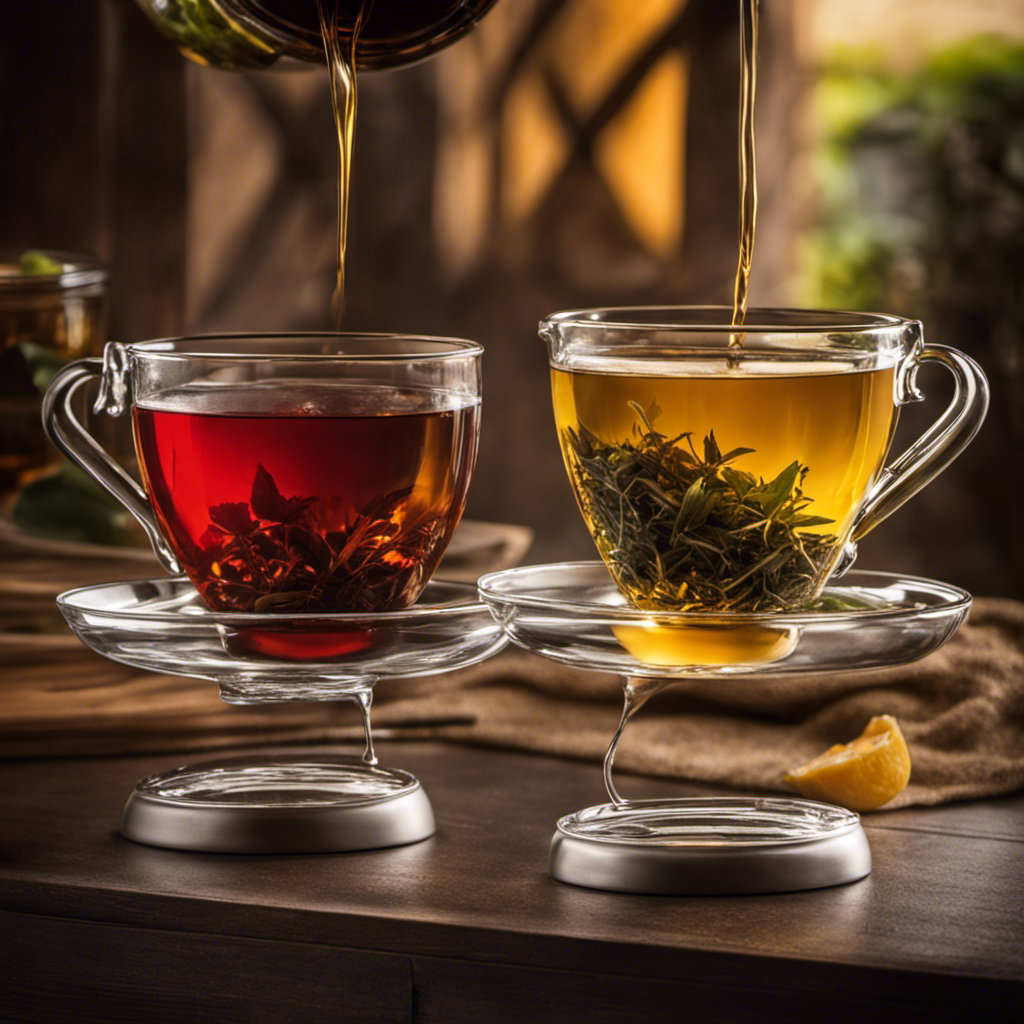Raw Cacao
What Are Raw Organic Cacao Nibs
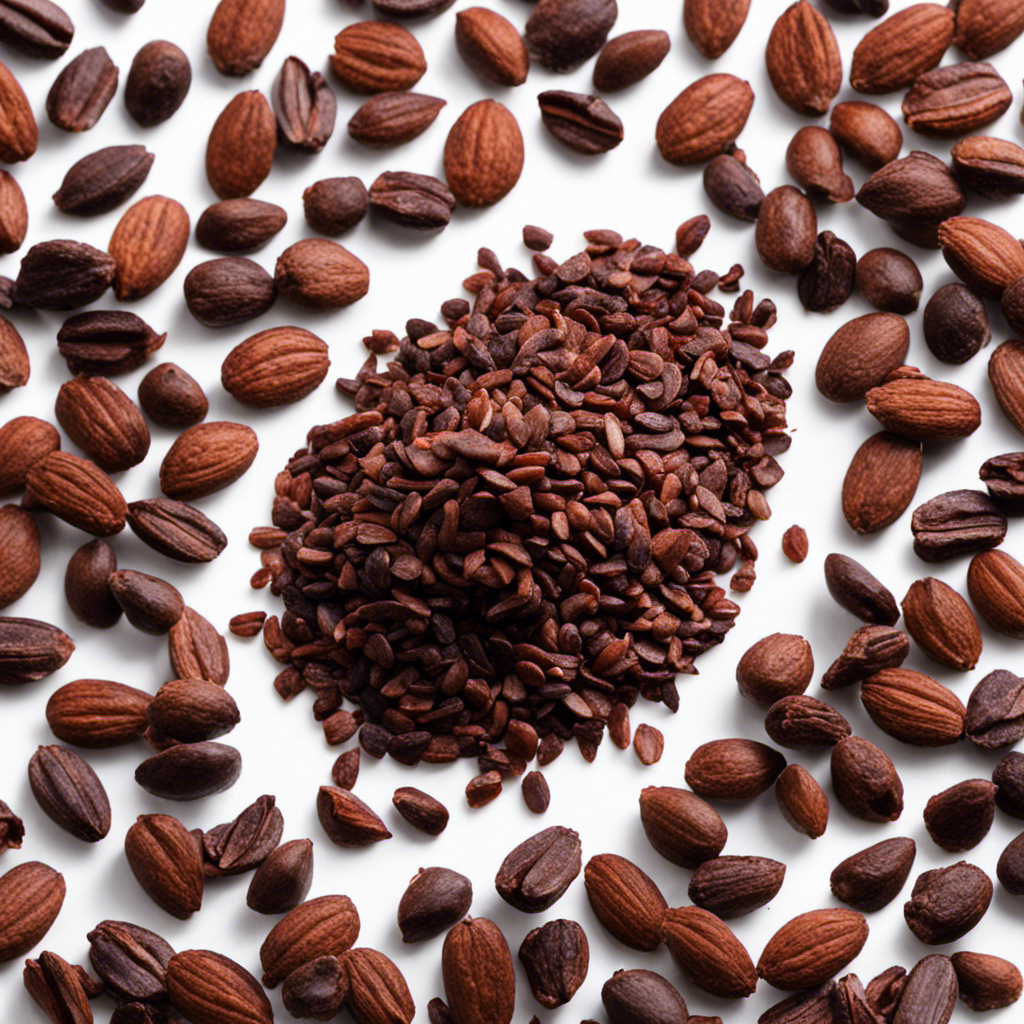
Did you know that raw organic cacao nibs contain higher levels of antioxidants compared to blueberries, goji berries, and even green tea? This fact holds true! As a health and nutrition enthusiast, I am constantly searching for superfoods that can improve my well-being. Cacao nibs are definitely among them.
In this article, we will explore the origins of cacao nibs, their impressive nutritional value, and the numerous health benefits they offer. We’ll also delve into the culinary uses of cacao nibs and provide tips on how to choose and store them properly.
But that’s not all! We will also compare cacao nibs to chocolate and discuss how you can easily incorporate these crunchy little morsels into your diet. Of course, we’ll touch on some cautions and considerations to keep in mind as well.
Lastly, we’ll take a closer look at the importance of sustainable and ethical sourcing when it comes to cacao nibs. So, let’s dive in and discover why cacao nibs are becoming a popular choice for health-conscious individuals like myself.
Key Takeaways
- Raw organic cacao nibs are a delicious and nutritious treat.
- Cacao nibs can potentially trigger allergies and sensitivities, so individuals should be mindful of their reactions and consult with a healthcare professional if necessary.
- Cacao nibs can interact with certain medications, so it is important to consult with a healthcare provider if you are taking prescription medications.
- Choosing fair trade and organic certified cacao nibs supports sustainable farming practices, promotes social justice, and minimizes the environmental impact of cacao production.
The Origins of Cacao Nibs
Let’s take a journey back in time to uncover the rich and fascinating origins of cacao nibs.
The history of cacao cultivation can be traced back to ancient Mesoamerica, where the Mayans and Aztecs revered the cacao tree. They believed that cacao seeds were a divine gift from the gods and used them in religious ceremonies and as currency.
Cacao nibs, which are simply crushed cacao beans, were highly valued for their intense flavor and nutritional properties. They were often ground into a paste and mixed with water to create a frothy beverage called xocoatl, which was enjoyed by nobility and warriors.
Today, cacao nibs continue to hold cultural significance, being used in various culinary creations and enjoyed for their rich chocolate flavor.
Now, let’s delve into the nutritional value of cacao nibs.
The Nutritional Value of Cacao Nibs
Cacao nibs are known for their high antioxidant content, making them a valuable addition to a healthy diet. These antioxidants help protect the body’s cells from damage caused by harmful free radicals.
Additionally, cacao nibs are rich in essential minerals such as magnesium, iron, and zinc, which are important for various bodily functions and overall well-being.
They also provide a good source of vitamins, including vitamin E, which plays a role in maintaining healthy skin and immune function.
Antioxidant content
Indulge in the rich treasure trove of antioxidants found in raw organic cacao nibs, where your taste buds will dance with the vibrant power of nature’s protective warriors. Antioxidants play a crucial role in preventing diseases and promoting overall health. Here are four reasons why the antioxidant content of cacao nibs is beneficial:
-
Protects against oxidative stress: Antioxidants neutralize harmful free radicals, reducing oxidative stress and the risk of chronic diseases like heart disease and cancer.
-
Supports brain health: Cacao nibs contain flavanols that can improve cognitive function and protect against age-related cognitive decline.
-
Promotes heart health: Antioxidants in cacao nibs help lower blood pressure, reduce inflammation, and improve blood flow, all of which contribute to a healthy heart.
-
Boosts immune system: Antioxidants support a strong immune system, helping the body fight off infections and diseases.
Now, let’s explore the next section about essential minerals and vitamins found in cacao nibs.
Essential minerals and vitamins
One can benefit from the essential minerals and vitamins found in cacao nibs by incorporating them into their diet. Cacao nibs are a rich source of several essential minerals, including magnesium, iron, and potassium.
Magnesium plays a crucial role in various bodily functions, such as nerve function and muscle contraction. Iron is essential for the production of red blood cells and transporting oxygen throughout the body. Potassium helps maintain proper heart and muscle function.
In addition to minerals, cacao nibs also contain vitamins, including vitamin E and B vitamins. Vitamin E is an antioxidant that helps protect cells from damage, while B vitamins are important for energy production and brain health.
Incorporating cacao nibs into your diet can provide you with these essential minerals and vitamins, promoting overall health and well-being.
Moving on to the health benefits of cacao nibs, their antioxidant content is particularly noteworthy.
Health Benefits of Cacao Nibs
You won’t believe the incredible health benefits you’re missing out on if you haven’t tried these raw organic cacao nibs! These small pieces of pure cacao beans are packed with essential minerals and vitamins that can support your overall well-being. Cacao nibs are a rich source of antioxidants, which can help protect your cells from damage caused by harmful free radicals. They are also high in fiber, which aids in digestion and promotes a healthy gut. Additionally, cacao nibs contain flavanols that have been linked to improved heart health and reduced inflammation. To visualize the benefits, take a look at the table below:
| Health Benefits of Cacao Nibs | Emotion |
|---|---|
| Antioxidant-rich | Protection |
| High in fiber | Digestive health |
| Contains flavanols | Heart health |
Now that you know about the health benefits, let’s explore the culinary uses of cacao nibs.
Culinary Uses of Cacao Nibs
Now that we’ve explored the health benefits of cacao nibs, let’s delve into their culinary uses.
Cacao nibs are a versatile ingredient that can add a rich and intense flavor to a variety of dishes. They have a slightly bitter taste, reminiscent of dark chocolate, which pairs well with both sweet and savory recipes.
In baking, cacao nibs can be used as a substitute for chocolate chips, adding a delightful crunch and a burst of chocolate flavor. They can also be sprinkled over desserts, such as ice cream or yogurt, for added texture.
In savory dishes, cacao nibs can be incorporated into spice rubs for meats or used as a topping for salads or roasted vegetables. With their unique flavor profiles, cacao nibs can elevate any dish to a whole new level of deliciousness.
Speaking of flavor, let’s now explore how to choose and store cacao nibs…
How to Choose and Store Cacao Nibs
To choose the best quality cacao nibs, consider their appearance, aroma, and packaging. Look for dark brown nibs with a shiny texture and a strong chocolatey smell. Opt for nibs packaged in airtight containers to maintain freshness. Remember that there are different types of cacao nibs, such as raw and roasted. Raw nibs are minimally processed and retain more nutrients, while roasted nibs have a different flavor.
Cacao Nibs vs. Chocolate
When comparing cacao nibs and chocolate, it’s important to understand their distinct characteristics and flavor profiles.
Cacao nibs are the purest form of chocolate, made from crushed and roasted cacao beans. They have a rich, intense flavor with a slightly bitter taste.
Unlike chocolate, cacao nibs are unprocessed and contain no added sugar or dairy. This makes them a healthier option, as they are packed with nutrients and antioxidants.
Cacao nibs are known for their numerous benefits, including improved heart health, enhanced mood, and increased energy levels.
They can be enjoyed on their own as a snack or used as a versatile ingredient in various recipes. From smoothies to baked goods, incorporating cacao nibs into your diet can add a delicious and nutritious twist to your favorite dishes.
Incorporating Cacao Nibs into Your Diet
Adding these little nuggets of chocolatey goodness to your meals is like sprinkling a dash of magic into your everyday routine. Not only do cacao nibs add a rich, intense flavor to your dishes, but they also come with numerous health benefits.
For those looking to shed a few pounds, cacao nibs can be a great addition to your weight loss journey. Packed with fiber and healthy fats, they help keep you feeling full and satisfied, reducing the temptation to snack on unhealthy foods.
Moreover, cacao nibs are a perfect ingredient for vegan desserts. You can incorporate them into your favorite recipes like cookies, brownies, or energy balls, adding a delightful crunch and intense chocolate flavor.
So go ahead and enjoy these nutritious nibs in your diet, but remember to be mindful of a few cautions and considerations.
Cautions and Considerations
When incorporating cacao nibs into my diet, it’s important to consider potential allergies and sensitivities. Some individuals may be allergic to cacao or have sensitivities to its compounds, such as caffeine or theobromine.
In addition, it’s crucial to be aware of potential side effects and interactions with medications. Cacao nibs can have stimulating effects and may interact with certain medications, such as blood thinners or antidepressants.
Allergies and sensitivities
If you’re prone to allergies or sensitivities, it’s important to be aware of the potential effects that raw organic cacao nibs can have on your body. While cacao nibs are generally safe for consumption, allergic reactions have been reported in some individuals. It’s recommended to consult with a healthcare professional if you have any known allergies or dietary restrictions before incorporating cacao nibs into your diet. Here are four important considerations regarding allergies and sensitivities when consuming cacao nibs:
-
Cross-reactivity: If you have a known allergy to tree nuts, there is a possibility of cross-reactivity with cacao nibs due to their similar protein structure.
-
Histamine release: Cacao contains natural compounds that may trigger histamine release, potentially causing allergic symptoms in sensitive individuals.
-
Sulfite sensitivity: Some cacao products may contain sulfites, which can be problematic for those with sulfite sensitivity or asthma.
-
Gluten-free status: Raw organic cacao nibs are naturally gluten-free, making them suitable for individuals with gluten intolerance or celiac disease.
Understanding these potential effects and considering your own allergies or sensitivities is crucial when incorporating cacao nibs into your diet. It’s also important to explore potential side effects and interactions with medications.
Potential side effects and interactions with medications
Be cautious when incorporating these delicious nuggets of goodness into your diet, as they may have potential side effects and interact with certain medications.
While cacao nibs are generally safe for consumption, it’s important to be aware of their potential drug interactions. Cacao contains compounds that can affect the metabolism of certain medications, such as antidepressants and anticoagulants. It’s recommended to consult with your healthcare provider before adding cacao nibs to your diet, especially if you are taking any prescription medications.
Additionally, it’s important to note that cacao nibs are quite rich in caffeine, which can cause side effects such as increased heart rate and insomnia, particularly when consumed in large amounts. Therefore, it is advisable to consume cacao nibs in moderation and be mindful of your overall caffeine intake.
Transitioning to the subsequent section, let’s explore the sustainable and ethical sourcing of cacao nibs.
Sustainable and Ethical Sourcing of Cacao Nibs
When it comes to sourcing cacao nibs, two key points to consider are fair trade and organic certifications. Fair trade certifications ensure that cacao farmers receive fair wages and are working in safe conditions, while organic certifications guarantee that the cacao beans are grown without the use of synthetic pesticides or fertilizers.
Additionally, supporting sustainable cacao farming practices is important for the long-term viability of the industry, as it promotes techniques that conserve natural resources and protect the environment.
Fair trade and organic certifications
Certified both fair trade and organic, raw organic cacao nibs are a visual representation of ethical and sustainable farming practices. Fair trade benefits ensure that farmers receive fair wages and work in safe conditions, promoting social justice and economic stability within their communities.
Organic farming methods used to cultivate cacao nibs prioritize environmental sustainability by avoiding synthetic pesticides and fertilizers, reducing soil erosion, and protecting biodiversity. This ensures that the cacao trees and surrounding ecosystems remain healthy for generations to come.
By supporting sustainable cacao farming practices, consumers can contribute to the preservation of rainforests, the livelihoods of farmers, and the production of high-quality, ethically-sourced cacao.
Transitioning into the subsequent section, it is important to understand the impact of supporting sustainable cacao farming on the global chocolate industry.
Supporting sustainable cacao farming practices
After discussing fair trade and organic certifications, let’s delve into the importance of supporting sustainable cacao farming practices.
It is crucial to understand that fair trade practices go beyond providing fair wages to farmers. They also emphasize environmentally friendly farming techniques that minimize the impact on the ecosystem.
Supporting sustainable cacao farming practices means promoting agroforestry, where cacao trees are grown alongside other crops, such as fruits and nuts. This promotes biodiversity and helps maintain soil fertility.
Additionally, it involves reducing the use of harmful chemicals and pesticides, thereby protecting the health of both farmers and consumers. Implementing sustainable practices ensures the long-term viability of cacao farming while preserving the delicate balance of the environment.
By choosing raw organic cacao nibs, you are not only enjoying a delicious and nutritious treat, but also supporting fair trade practices and minimizing the environmental impact of cacao production.
Frequently Asked Questions
Are cacao nibs safe for people with nut allergies?
Yes, cacao nibs are safe for people with nut allergies. They are a nutritious addition to smoothies, providing antioxidants, fiber, and minerals. However, it is always advisable to check the packaging for any potential cross-contamination with nuts.
Can cacao nibs be used as a substitute for cocoa powder in baking recipes?
Sure, cacao nibs can be used as a substitute for cocoa powder in baking recipes. They provide a rich, intense chocolate flavor and add a crunchy texture. Just grind them into a powder before using.
Can cacao nibs help with weight loss?
Cacao nibs can aid in weight loss due to their high fiber content, which promotes feelings of fullness and reduces overeating. Additionally, their natural caffeine content provides a boost of energy. Try incorporating cacao nibs into smoothies for added benefits.
Are cacao nibs suitable for vegans and vegetarians?
As a vegan or vegetarian, cacao nibs are a delightful substitute for traditional chocolate. They offer the same health benefits, like antioxidants and mood-boosting properties, without any animal products.
How do cacao nibs taste compared to chocolate?
Cacao nibs have a slightly bitter taste compared to chocolate, due to their pure and unprocessed form. They contain more antioxidants, fiber, and minerals, making them a healthier choice than chocolate.
Conclusion
In conclusion, it’s safe to say that raw organic cacao nibs are a delightful treasure trove of goodness.
Their origins can be traced back to ancient civilizations, and they pack a powerful punch of nutrition.
With numerous health benefits and versatile culinary uses, cacao nibs are a great addition to any diet.
However, it’s important to choose and store them wisely, and be mindful of their differences from chocolate.
When incorporated thoughtfully, cacao nibs can bring joy and vitality to your life.
Let the journey of exploring these sustainable and ethically sourced gems begin!
Arf, an author and an innovative enthusiast of coffee, coffee alternatives, and tea, plays a crucial role as a contributor to the esteemed Cappuccino Oracle platform. Renowned for his curiosity and passion for these captivating beverages, Arf has carved out a unique space for himself in the world of exploration and writing. He realized that coffee, coffee alternatives, and tea are not mere drinks to keep one awake, but universes of flavors and stories waiting to be explored.
Arf’s articles for Cappuccino Oracle blend meticulous research with personal experiences, providing readers with an in-depth understanding of various types of coffee, coffee alternatives, and tea, along with their unique characteristics, cultures, and histories. His honest reviews and engaging narratives guide readers on their own journeys, helping them discover their preferences and find their perfect brew.
Raw Cacao
How To Make Chocolate Bars From Raw Cacao
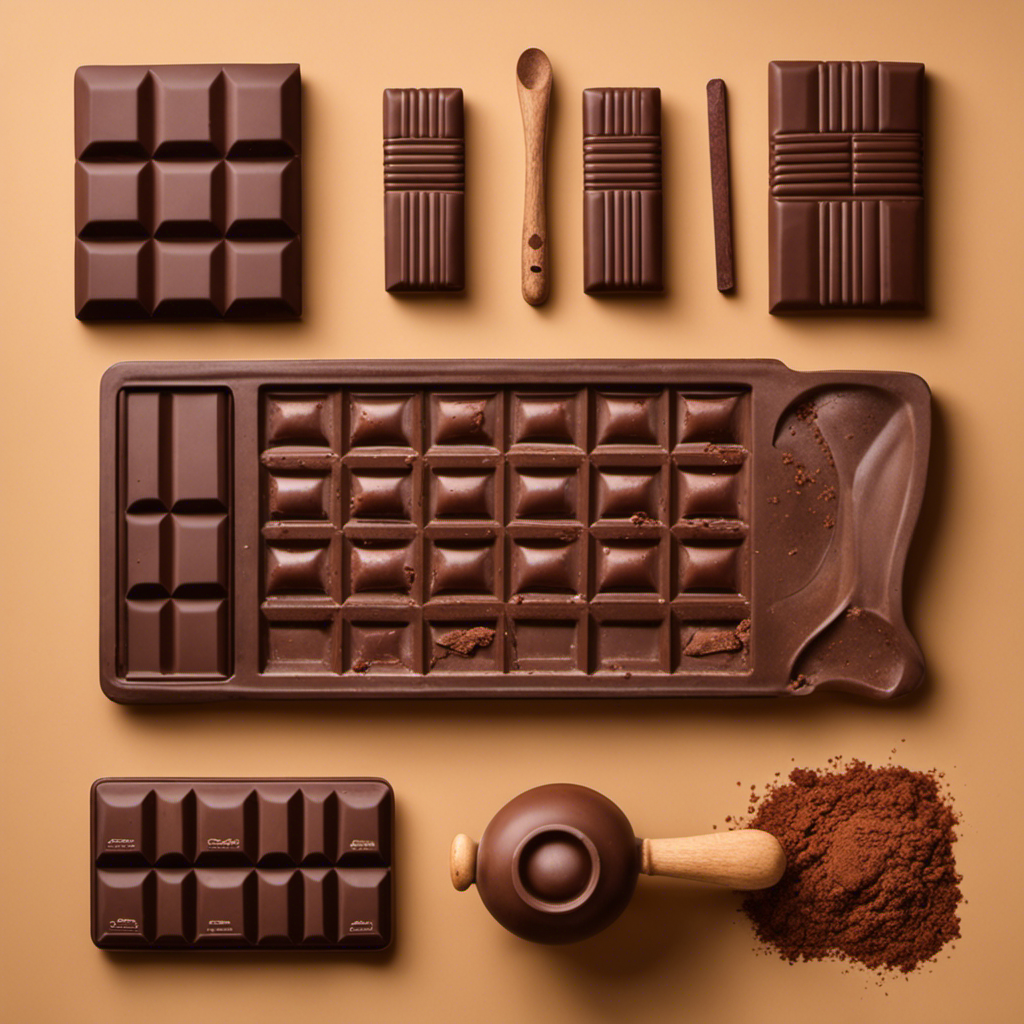
Envision the enticing scent of newly roasted cacao beans permeating your kitchen space, as you delve into the adventure of crafting your very own scrumptious chocolate bars from the beginning. Through this article, I’ll lead you through the detailed procedure of turning unprocessed cacao into luscious chocolate bars that are sure to tantalize your palate.
With a few simple ingredients and some basic techniques, you can unlock the true potential of cacao and experience the joy of crafting your own chocolate creations. From roasting and grinding the cacao beans to melting and tempering the chocolate, I will walk you through each stage, ensuring that you achieve the perfect texture and flavor.
We will also explore the art of adding sweeteners and flavors, as well as experimenting with various toppings and decorations.
So, roll up your sleeves and get ready to indulge in the world of homemade chocolate bars made from raw cacao.
Key Takeaways
- Cacao farming involves cultivating and harvesting cacao trees.
- Different varieties of cacao have unique flavors, such as delicate Criollo, robust Forastero, and balanced Trinitario.
- Sweeteners like honey, maple syrup, and coconut sugar balance the bitterness of raw cacao.
- Additional flavors and add-ins, such as cinnamon, chili powder, mint, sea salt, caramel, orange zest, dark chocolate, crushed nuts, dried fruits, and espresso powder, enhance taste and texture of chocolate bars made from raw cacao.
Introduction to Raw Cacao
Let’s dive into the wonderful world of raw cacao and discover how to transform it into delicious chocolate bars!
Raw cacao is the purest form of chocolate, packed with incredible health benefits. It is rich in antioxidants, minerals like iron and magnesium, and contains mood-enhancing compounds like phenylethylamine.
There are different varieties of raw cacao, each with its unique flavor profile and characteristics. Criollo, known for its delicate flavor and low bitterness, is often considered the finest variety. Forastero, on the other hand, is more robust and widely used in chocolate production. Trinitario, a hybrid of Criollo and Forastero, offers a balance of flavors.
Now that we understand the health benefits and different varieties of raw cacao, let’s move on to gathering the ingredients needed for making our chocolate bars.
Gathering the Ingredients
In gathering the ingredients for making chocolate bars from raw cacao, I’ll need to start with raw cacao beans. These beans are the foundation of the chocolate and provide the rich, deep flavor.
Next, I’ll need to choose a sweetener such as honey or maple syrup to balance out the bitterness of the cacao.
Lastly, I can add additional flavors and add-ins such as vanilla extract, sea salt, or nuts to enhance the taste and texture of the chocolate.
Raw Cacao Beans
To truly experience the magic of creating chocolate bars, imagine holding a handful of raw cacao beans. These little gems are waiting to be transformed into rich, velvety goodness. Raw cacao beans are the foundation of chocolate, and understanding their origins is essential to appreciating the final product.
Cacao farming is a complex process that involves cultivating and harvesting cacao trees, which thrive in tropical climates. These beans have been cherished for centuries not only for their delicious flavor but also for their potential health benefits. Cacao is rich in antioxidants, which can help fight inflammation and improve heart health. It also contains minerals like magnesium, iron, and zinc, which are essential for various bodily functions.
Now that we understand the importance of raw cacao beans, let’s explore the next crucial ingredient: sweeteners.
Sweeteners
Imagine the delight of discovering the perfect sweetener to complement the natural richness of cacao beans and enhance the flavor of your homemade chocolate creations.
When it comes to sweetening raw cacao, there are plenty of natural alternatives that not only add a touch of sweetness but also provide health benefits. One popular option is raw honey, which not only adds a subtle sweetness but also contains antioxidants and enzymes that can boost your immune system.
Another great choice is maple syrup, which adds a rich and complex flavor to your chocolate bars. Not only is it a natural sweetener, but it also contains minerals like manganese and zinc.
And let’s not forget about coconut sugar, a low glycemic sweetener that adds a caramel-like taste.
Incorporating these natural sweeteners into your raw cacao creations will elevate the taste and provide additional health benefits.
Now, let’s explore the world of additional flavors and add-ins to take your chocolate bars to the next level.
Additional Flavors and Add-ins
Adding different flavors and add-ins to your homemade chocolate creations can elevate the taste and provide a unique twist. Incorporating spices like cinnamon or chili powder, according to a study published in the Journal of Food Science, can enhance the flavor and add a hint of warmth to your chocolate.
Different flavor combinations:
- Mint and dark chocolate for a refreshing twist.
- Sea salt and caramel for a sweet and savory combination.
- Orange zest and dark chocolate for a citrusy burst.
Creative mix-ins:
- Crushed nuts like almonds or hazelnuts for added crunch.
- Dried fruits such as cranberries or raisins for a burst of sweetness.
- Espresso powder for a subtle coffee flavor.
By experimenting with these different flavors and mix-ins, you can create your own signature chocolate bars that are sure to impress.
In the next section, we will delve into the process of roasting and grinding the cacao beans, a crucial step in making chocolate from scratch.
Roasting and Grinding the Cacao Beans
Once the cacao beans have been roasted and ground, they transform into a rich and flavorful base for creating chocolate bars. Roasting techniques are crucial in developing the desired flavor profile of the chocolate. Different temperatures and durations can impart distinct characteristics, such as nuttiness or fruity notes. For example, a lower temperature of around 250°F (121°C) for a longer time will result in a deeper, more complex flavor. Grinding methods are equally important in achieving the desired texture and smoothness. Traditional stone mills or modern equipment like conching machines can be used to grind the roasted cacao beans into a fine paste, known as chocolate liquor. This step helps to release the natural fats, or cocoa butter, which contributes to the smoothness and melt-in-your-mouth feel of the final chocolate product. Transitioning into the subsequent section, the next step after roasting and grinding is melting and tempering the chocolate to achieve the perfect consistency.
Melting and Tempering the Chocolate
To achieve the perfect consistency, you’ll need to gently melt and artfully temper the luscious chocolate, transforming it into a silky and velvety delight.
Melting techniques play a crucial role in the chocolate-making process. There are two common methods: direct heat and indirect heat. With direct heat, the chocolate is melted in a double boiler or microwave, ensuring a controlled temperature and preventing scorching. Indirect heat involves melting the chocolate using hot water or a warm environment.
Once the chocolate is melted, the tempering process begins. Tempering is the method of carefully cooling and reheating the chocolate to stabilize its cocoa butter crystals, resulting in a glossy finish and a firm texture. This is achieved by gradually lowering the temperature and then raising it again, following precise timing and stirring techniques.
As we move into the next section about adding sweeteners and flavors, it’s important to maintain the tempered state of the chocolate.
Adding Sweeteners and Flavors
Enhance the lusciousness of your chocolatey creation by infusing it with a tantalizing blend of sweeteners and flavors. Experimenting with different sweeteners allows you to customize the level of sweetness in your chocolate bars. Popular options include cane sugar, maple syrup, honey, and coconut sugar. Each sweetener brings its own unique taste profile to the table, so don’t be afraid to get creative and try out new combinations.
In addition to sweeteners, exploring unique flavor combinations can take your chocolate bars to the next level. Consider adding a pinch of sea salt for a delightful salty-sweet contrast, or try incorporating spices like cinnamon or chili powder for an exciting twist.
To help you in your sweetener and flavor experimentation, here’s a handy table showcasing some popular options:
| Sweeteners | Flavors |
|---|---|
| Cane sugar | Sea salt |
| Maple syrup | Cinnamon |
| Honey | Chili powder |
| Coconut sugar | Vanilla extract |
By adding these sweeteners and flavors, you can create a truly unique and delicious chocolate bar. Now, let’s move on to pouring and setting the chocolate.
Pouring and Setting the Chocolate
Now it’s time to pour your delectable chocolate mixture into molds and let it set into irresistible treats. But before you start pouring, it’s important to master the pouring techniques to achieve the perfect consistency.
First, hold the mold steady and pour the chocolate mixture slowly and steadily. This will ensure that the chocolate fills every nook and cranny of the mold, creating a smooth and even surface.
Second, tap the mold gently on the countertop to remove any air bubbles that may have formed during the pouring process. This will prevent any unsightly holes or gaps in your chocolate bars.
Lastly, let the chocolate set undisturbed for at least 1-2 hours, or until it becomes firm and solid.
Once your chocolate bars have set, you can move on to the exciting step of adding toppings and decorations, which will take your homemade treats to the next level.
Adding Toppings and Decorations
Once your chocolate bars have set, you can take them to the next level by adding a variety of enticing toppings and decorations. Some options include crushed nuts, colorful sprinkles, or a drizzle of caramel sauce. The possibilities for toppings are endless, so feel free to get creative and make your chocolate bars truly unique.
Try adding a sprinkle of sea salt for a savory twist, or dusting them with edible gold dust for a touch of elegance. You can even experiment with different textures by adding crunchy toffee bits or smooth peanut butter swirls.
These toppings not only enhance the visual appeal of your homemade chocolates but also add layers of flavor and texture.
Now, let’s move on to storing and enjoying your homemade chocolate bars.
Storing and Enjoying Your Homemade Chocolate Bars
To fully enjoy your homemade chocolate bars, you’ll want to know the best way to store them and savor their delicious flavors. Proper storage techniques are essential to maintain the quality and freshness of your chocolate bars. Here are some tips to help you store your homemade chocolate bars effectively:
| Storing Technique | Description |
|---|---|
| Refrigeration | Store your chocolate bars in an airtight container in the fridge. |
| Freezing | Wrap your chocolate bars tightly in plastic wrap and freeze them. |
| Room Temperature | Keep your chocolate bars in a cool, dry place away from sunlight. |
Pairing Suggestions:
- Dark chocolate pairs well with red wine or strong coffee.
- Milk chocolate complements fruity desserts or a glass of cold milk.
- White chocolate goes perfectly with a hot cup of tea or a creamy dessert.
In the next section, we will discuss troubleshooting and tips to ensure your chocolate bars turn out perfectly.
Troubleshooting and Tips
If you’re experiencing any issues or need some helpful advice, here’s a tip to enhance your chocolate bar-making experience: Did you know that adding a pinch of salt to your chocolate mixture can enhance the overall flavor and bring out the richness of the cocoa? It may seem counterintuitive, but the salt acts as a flavor enhancer, balancing the sweetness and intensifying the chocolate taste.
Additionally, here are some troubleshooting tips and common mistakes to avoid:
- Avoid overheating the chocolate as it can cause it to seize or become grainy.
- Make sure all your equipment is completely dry before starting the process to prevent any water from causing the chocolate to seize.
- If your chocolate bar doesn’t have a smooth texture, try tempering it by carefully heating and cooling it to create stable cocoa butter crystals.
By following these troubleshooting tips and avoiding common mistakes, you’ll be able to create delicious homemade chocolate bars every time.
Frequently Asked Questions
How do I source high-quality raw cacao beans?
To source high-quality raw cacao beans, I recommend exploring different sourcing options such as reputable online suppliers, specialty grocery stores, or local farmers markets. Look for quality indicators like organic certifications and fair trade labels to ensure the beans are of the highest quality.
Can I use a regular oven instead of a specialized roasting machine to roast the cacao beans?
Yes, a regular oven can be used to roast cacao beans. However, it is important to maintain a consistent temperature and monitor the beans closely. Alternative sweeteners like honey or coconut sugar can be used in chocolate bars.
Is it necessary to temper the chocolate when making chocolate bars from raw cacao?
Tempering is not necessary when making chocolate bars from raw cacao. There are tempering alternatives, such as using cocoa butter or adding lecithin, that achieve similar results. However, not tempering can result in a dull appearance and less stable texture.
Can I use alternative sweeteners like maple syrup or honey instead of sugar?
Using alternative sweeteners like maple syrup or honey in chocolate bars can provide health benefits. They add natural sweetness and unique flavors. However, they may alter the texture and taste of the final product.
How long does it take for the chocolate bars to fully set and harden?
The setting time for chocolate bars to fully harden varies, typically taking 1-2 hours at room temperature. During this time, the chocolate undergoes a fascinating transformation, gradually solidifying into a smooth and irresistibly firm texture.
Conclusion
As I gaze upon the glossy surface of my homemade chocolate bars, I am reminded of the transformation that took place. From the humble raw cacao beans to the velvety chocolate delight, each step in the process symbolized growth and mastery.
The roasting and grinding unleashed the hidden potential within the beans, while the melting and tempering brought forth their true beauty. With sweeteners and flavors, a symphony of tastes emerged.
Pouring and setting, like a skilled artist, I crafted each bar with care. Now, as I savor the fruits of my labor, I am filled with a sense of accomplishment and joy.
Arf, an author and an innovative enthusiast of coffee, coffee alternatives, and tea, plays a crucial role as a contributor to the esteemed Cappuccino Oracle platform. Renowned for his curiosity and passion for these captivating beverages, Arf has carved out a unique space for himself in the world of exploration and writing. He realized that coffee, coffee alternatives, and tea are not mere drinks to keep one awake, but universes of flavors and stories waiting to be explored.
Arf’s articles for Cappuccino Oracle blend meticulous research with personal experiences, providing readers with an in-depth understanding of various types of coffee, coffee alternatives, and tea, along with their unique characteristics, cultures, and histories. His honest reviews and engaging narratives guide readers on their own journeys, helping them discover their preferences and find their perfect brew.
Raw Cacao
How To Make Raw Cacao Butter”
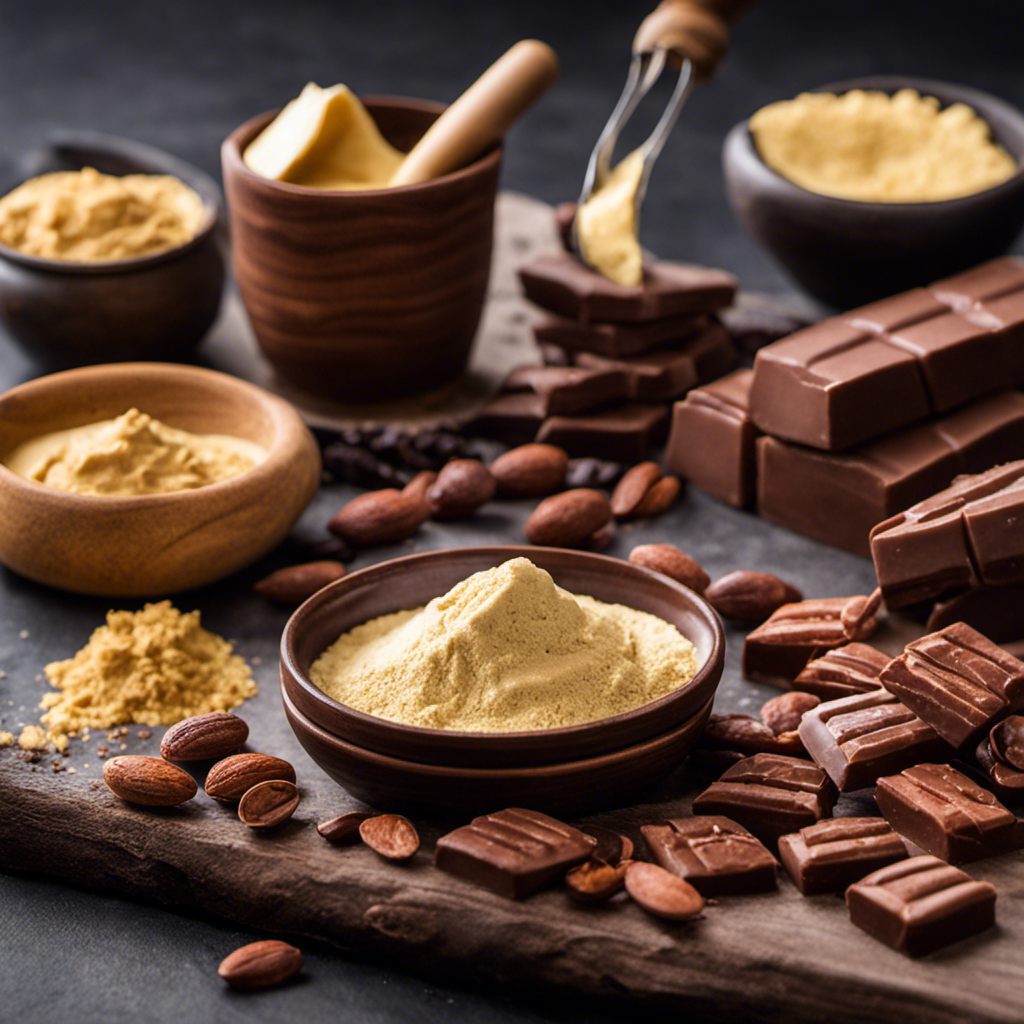
Immersing myself in the realm of gastronomic endeavors, I become mesmerized by the lush and creamy charm of raw cacao butter. This opulent component, distinguished by its profound scent and silky consistency, is the gateway to exploring a universe filled with succulent options.
Allow me to guide you through the process of creating your very own raw cacao butter, step by step, ensuring every detail is accurately described.
With a scientific approach, we will explore the chemical processes involved in making cacao butter, from the role of fats to the art of emulsification and temperature control. As we delve into the technical aspects, we will employ precise measurements, temperatures, and techniques to achieve the desired result.
But this journey is not purely scientific; it is also one of knowledge and information. We will uncover the nutritional content and potential health benefits of raw cacao butter, as well as its versatility in culinary delights.
So, gather your ingredients and equipment, for we are about to embark on a tantalizing adventure into the world of homemade raw cacao butter.
Key Takeaways
- Raw cacao butter is a luxurious ingredient with a rich aroma and smooth texture, suitable for culinary and skincare uses.
- The process of making raw cacao butter involves roasting high-quality cacao beans, grinding them to extract the fats, and separating the nibs from the husks for purity.
- Melting and straining the cacao butter requires controlled temperature for proper tempering and straining for a smoother consistency.
- After melting, the cacao butter can be poured into molds or containers for portioning and should be allowed to solidify in a cool, dry area. Proper storage in an airtight container can extend its shelf life.
Gather the Necessary Ingredients and Equipment
To make raw cacao butter, gather the necessary ingredients and equipment. Start by getting high-quality cacao beans, preferably organic and fair-trade. You can find them at specialty stores or order online. Also, you’ll need a grinder or food processor to crush the beans into a fine powder. Use a double boiler or a heat-resistant bowl over simmering water for melting the ground cacao beans. Have a spatula or whisk for stirring the mixture. For shaping the cacao butter, use different types of chocolate molds in various shapes and sizes. It’s worth mentioning that cacao butter has alternative uses, such as in skincare products or as a moisturizer. Once you have everything, proceed to the next step of roasting and grinding the cacao beans.
Roast and Grind the Cacao Beans
Once you’ve got your hands on those rich cacao beans, it’s time to roll up your sleeves and get ready to roast and grind them into a heavenly concoction.
To bring out the full flavor of the cacao beans, there are various roasting techniques you can employ. You can opt for a low and slow roast, which involves baking the beans at a low temperature for a longer duration, or a high heat roast, which quickly develops a rich aroma.
After roasting, it’s time to grind the beans. There are different grinding methods available, such as using a mortar and pestle or a specialized grinder. The grinding process helps break down the beans into smaller particles, allowing the fats to be extracted more efficiently.
Once the beans are ground to a fine consistency, you can proceed to the next step of separating the cacao nibs from the husks.
Separate the Cacao Nibs from the Husks
To free the precious cacao nibs from their husky confines, it’s time to employ a nifty technique that will have you separating them with ease. First, gather your roasted cacao beans and place them into a clean bowl. Using your hands or a utensil, gently crush the beans, ensuring that the husks begin to separate from the nibs.
Next, transfer the crushed beans into a large sieve or colander and shake it gently. As you do this, the lighter husks will float to the top, while the heavier nibs will remain at the bottom. Carefully remove the husks, preserving the valuable nibs.
By separating the cacao nibs from the husks, you ensure that you have the purest form of cacao for making raw cacao butter. This process also allows you to reap the benefits of using raw cacao butter in skincare.
Now, let’s move on to the next step: melting the cacao nibs.
Melt the Cacao Nibs
Now that you’ve separated the precious cacao nibs from their husks, it’s time to unleash their rich and velvety potential by melting them into a luscious liquid chocolate potion.
To begin, measure out the desired amount of cacao nibs and place them in a heat-safe bowl. Using a double boiler or microwave, gently apply heat to the nibs until they melt completely. It’s crucial to maintain a controlled temperature throughout the melting process to properly temper the cacao butter. The ideal range is between 104-113°F (40-45°C).
Stir the melted cacao butter occasionally to ensure even heating and smooth texture. Once fully melted, remove from heat and allow it to cool slightly before using in recipes. Tempered raw cacao butter adds a glossy finish and enhances the texture of desserts and confections.
Now, let’s move on to the next step and strain the melted cacao for a smoother consistency.
Strain the Melted Cacao
After melting the cacao nibs into a luscious liquid, it’s time to strain the velvety chocolate to achieve a smoother and more refined consistency. To strain the melted cacao, you will need a fine mesh strainer or cheesecloth. Place the strainer or cheesecloth over a bowl or container to catch the strained cacao. Carefully pour the melted cacao into the strainer, allowing the liquid to flow through while capturing any solid particles. Gently press down on the cacao solids to extract as much liquid as possible. This process helps remove any remaining bits of cacao nibs and ensures a silky texture for the final product. Once strained, your raw cacao butter is ready for the next step: pouring the melted cacao into molds or containers. This will create convenient portions for future use in various culinary creations.
Pour the Melted Cacao into Molds or Containers
Once you’ve achieved the desired consistency, it’s time to transfer the smooth, velvety liquid into molds or containers for easy portioning and future culinary adventures. Molding techniques play a crucial role in shaping the cacao butter into desired forms.
Silicone molds are highly recommended as they allow for easy removal and maintain the integrity of the cacao butter. Alternatively, you can use ice cube trays or small glass jars as containers.
Carefully pour the melted cacao butter into the molds or containers, ensuring that they are filled to the desired level. To create uniform shapes, gently tap the molds or containers on a flat surface to release any trapped air bubbles.
Once filled, place the molds or containers in a cool, dry area to allow the cacao butter to solidify. This step ensures that the butter sets properly before moving on to the next stage of the process: allowing the cacao butter to solidify.
Allow the Cacao Butter to Solidify
Let the luscious liquid turn into a solid delight as you allow the cacao butter to firm up. To solidify the cacao butter, follow these precise and detailed steps:
- Place the molds or containers with the melted cacao butter in a cool and dry area.
- Ensure that the temperature is around 55-65°F (13-18°C) to facilitate the solidifying process.
- Avoid placing the cacao butter in the refrigerator, as it can cause rapid solidification and affect the texture.
- Leave the cacao butter undisturbed for approximately 2-3 hours, or until it reaches a solid state.
- During this time, the fats in the cacao butter will undergo crystallization, resulting in a smooth and creamy texture.
Solidifying the cacao butter properly ensures that it maintains its desirable properties. The benefits of using raw cacao butter include its high content of healthy fats and antioxidants, which can contribute to improved heart health and overall well-being.
Once the cacao butter has solidified, it is ready to be stored properly for future use in culinary creations.
Store the Cacao Butter Properly
To properly store your solidified cacao butter, find a cool and dry spot where it can be safely tucked away for future culinary adventures. Proper storage techniques are crucial to extending the shelf life of your homemade raw cacao butter. Keep in mind that cacao butter is sensitive to light, heat, and moisture, so it’s important to protect it from these elements. I recommend using an airtight container made of glass or food-grade plastic to prevent any odors or contaminants from affecting the quality of your cacao butter. Additionally, store it away from any strong-smelling foods to avoid flavor transfer. It’s also a good idea to label the container with the date of preparation to keep track of its freshness. By following these storage guidelines, you can ensure that your homemade raw cacao butter stays fresh, flavorful, and ready to enhance your culinary creations. Now, let’s move on to the next section and learn how to enjoy your homemade raw cacao butter.
Enjoy Your Homemade Raw Cacao Butter
Now that you’ve successfully stored your culinary treasure, it’s time to indulge in the delicious possibilities that await with your homemade raw cacao butter.
To use raw cacao butter in recipes, start by gently melting it over low heat until it becomes a smooth liquid. It’s important to use low temperatures to preserve its delicate flavor and nutritional properties.
Once melted, you can incorporate the cacao butter into a wide range of recipes. It adds a rich and creamy texture to smoothies, desserts, and baked goods.
Additionally, raw cacao butter is known for its health benefits. It is packed with antioxidants, vitamins, and minerals that support cardiovascular health and boost mood. Its natural fats also provide a sustained source of energy.
So go ahead and experiment with this versatile ingredient to create delectable treats that are both delicious and nutritious.
Frequently Asked Questions
How long does it take for the cacao butter to solidify?
The solidification time of cacao butter can vary depending on several factors. To speed up the process, factors such as temperature, fat content, and emulsification techniques can be optimized.
Can I use a regular blender to grind the cacao beans?
Using a regular blender for grinding cacao beans is not recommended as it may not achieve the desired texture. Instead, alternative methods like using a food processor or a specialized grinder are more effective.
How should I store the cacao butter to ensure it stays fresh?
To ensure proper storage and maximize the shelf life of cacao butter, it should be stored in an airtight container in a cool, dark place, away from sunlight and moisture. This will help maintain its freshness and prevent oxidation.
Can I use roasted cacao beans instead of raw cacao beans?
Roasted cacao beans have a distinct flavor profile compared to raw cacao beans. The roasting process enhances the chocolatey taste and aroma, but it also reduces the nutritional content.
What are some common uses for raw cacao butter?
Raw cacao butter has various uses in skincare, as it helps moisturize and nourish the skin. In baking, it adds a rich, chocolatey flavor and enhances the texture of desserts. Its high antioxidant content provides potential health benefits.
Conclusion
In conclusion, making homemade raw cacao butter requires precision and attention to detail. By following the step-by-step instructions, you can successfully create this delicious and nutritious ingredient.
Remember to gather all the necessary ingredients and equipment, roast and grind the cacao beans, separate the nibs from the husks, melt the nibs, strain the melted cacao, and pour it into molds or containers.
Allow the cacao butter to solidify and store it properly. By understanding the scientific processes involved, you can fully appreciate the role of fats, emulsification, and temperature control in creating the perfect cacao butter.
Enjoy the rich and decadent flavors of your homemade creation, knowing that it offers numerous health benefits and endless culinary possibilities. So grab your apron and embark on this delightful journey to make your own raw cacao butter – it’s time to indulge in a little chocolate magic!
Arf, an author and an innovative enthusiast of coffee, coffee alternatives, and tea, plays a crucial role as a contributor to the esteemed Cappuccino Oracle platform. Renowned for his curiosity and passion for these captivating beverages, Arf has carved out a unique space for himself in the world of exploration and writing. He realized that coffee, coffee alternatives, and tea are not mere drinks to keep one awake, but universes of flavors and stories waiting to be explored.
Arf’s articles for Cappuccino Oracle blend meticulous research with personal experiences, providing readers with an in-depth understanding of various types of coffee, coffee alternatives, and tea, along with their unique characteristics, cultures, and histories. His honest reviews and engaging narratives guide readers on their own journeys, helping them discover their preferences and find their perfect brew.
Raw Cacao
What Is The Difference Between Raw Regular Cacao And Cocoa Powder
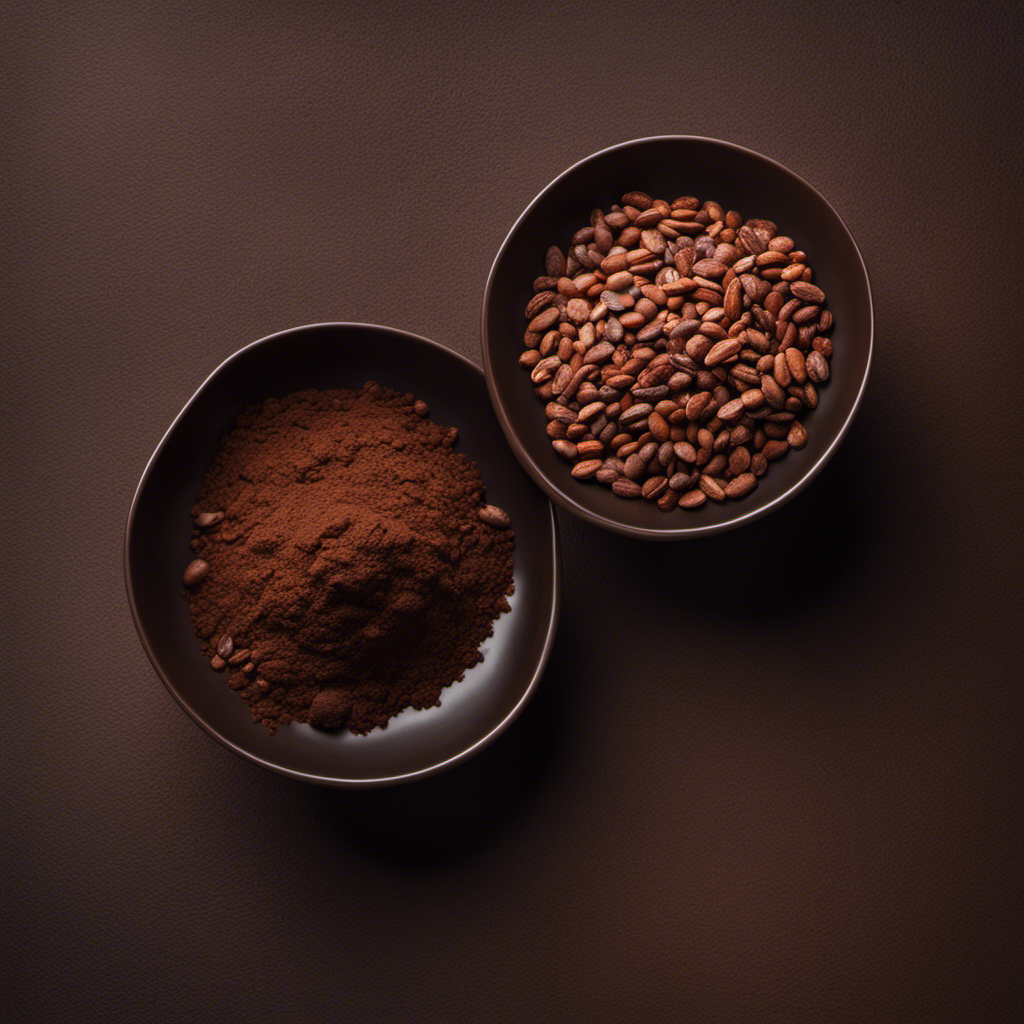
As I explore the realm of cacao and cocoa, I am fascinated by the delicate distinctions that set apart these two components. The inquiry arises: what sets raw, natural cacao apart from cocoa powder?
In this article, I aim to unravel the complexities and shed light on this intriguing topic.
Originating from the cacao tree, these two products undergo different processing methods, resulting in distinct flavor profiles and nutritional content. While cacao retains its raw, unprocessed form, cocoa powder undergoes a more intensive process involving roasting and grinding. Understanding these differences is crucial for culinary enthusiasts and health-conscious individuals alike.
Join me as we explore the origins, processing methods, nutritional content, and culinary uses of cacao and cocoa powder. We will also delve into availability, cost, sustainability, and storage considerations. By the end of this article, you will have a comprehensive understanding of these two ingredients and be equipped to make informed choices in your culinary endeavors.
So, let’s embark on this fascinating journey together.
Key Takeaways
- Raw cacao and cocoa powder are derived from the same source, but they undergo different processing methods.
- Raw cacao is made by cold-pressing unroasted cacao beans, while cocoa powder is produced by roasting the beans at high temperatures.
- Raw cacao retains more nutrients and antioxidants compared to cocoa powder due to minimal processing.
- When choosing between raw cacao and cocoa powder, factors to consider include flavor preferences, nutritional benefits, and support for sustainable and fair trade practices.
The Origins of Cacao and Cocoa
The rich history of cacao and cocoa will transport me to exotic lands and ignite my curiosity about their origins.
Cacao, the raw form of chocolate, comes from the cacao tree, which has been cultivated for thousands of years in Central and South America. The Mayans and Aztecs revered cacao for its cultural significance and used it in religious ceremonies.
Cocoa, on the other hand, is the processed form of cacao. To make cocoa powder, cacao beans are fermented, roasted, and ground into a fine powder. This processing technique removes the natural fats, known as cocoa butter, from the cacao beans. The difference between raw cacao and cocoa powder lies in their processing methods.
Now, let’s explore the various processing methods used to transform cacao into cocoa powder.
Processing Methods
When it comes to processing techniques, you’ll be surprised to discover the unique ways in which cacao and cocoa are transformed into delicious treats. The following list will give you an insight into the intricate process:
-
Fermentation: After the cacao beans are harvested, they undergo a fermentation process. This step is crucial as it develops the flavor profiles and reduces bitterness.
-
Roasting: The fermented beans are then roasted to enhance their aroma and deepen the flavors. Roasting also helps to remove moisture and further develop the chocolatey taste.
-
Grinding and Pressing: The roasted beans are ground into a paste, known as chocolate liquor. This paste is then pressed to separate the cocoa solids from the cocoa butter.
These processing methods not only bring out the distinct flavors but also impact the nutritional properties of cacao and cocoa.
Transitioning into the subsequent section about ‘nutritional content,’ let’s explore how these processing techniques affect the final products.
Nutritional Content
The discussion on the Nutritional Content of raw cacao and cocoa powder explores the health benefits of raw cacao and the nutritional differences between cacao and cocoa powder.
Raw cacao is rich in antioxidants, flavonoids, and minerals, which contribute to its potential health benefits such as improved cardiovascular health and mood enhancement.
On the other hand, cocoa powder is processed at a higher temperature, which reduces its nutritional content but still retains some health benefits.
Health benefits of raw cacao
Indulging in raw cacao can boost your health and give you a delectable treat at the same time. This superfood is packed with health benefits due to its minimal processing methods. Here are some reasons why raw cacao is a great addition to your diet:
-
High in antioxidants: Raw cacao contains a wide range of antioxidants that help fight free radicals and reduce inflammation.
-
Mood enhancer: Raw cacao stimulates the production of endorphins and serotonin, improving mood and promoting feelings of happiness.
-
Cardiovascular support: The flavonoids in raw cacao have been shown to lower blood pressure, improve circulation, and reduce the risk of heart disease.
-
Brain booster: Raw cacao is rich in flavonoids and other compounds that enhance cognitive function and improve memory.
-
Culinary versatility: Raw cacao can be used in various culinary creations, such as smoothies, desserts, and baked goods.
Understanding the health benefits of raw cacao sets the stage for exploring the nutritional differences between cacao and cocoa powder.
Nutritional differences between cacao and cocoa powder
One cannot help but be intrigued by the nutritional disparities found within the realm of cacao and cocoa powder.
When comparing the two, one notable difference is the theobromine content. Cacao powder contains a higher concentration of theobromine, a stimulant that can have positive effects on cardiovascular health, while cocoa powder has a lower theobromine content.
Another difference lies in their antioxidant levels. Cacao powder has a higher antioxidant content, which can help protect the body against oxidative stress and inflammation. Cocoa powder, on the other hand, undergoes processing that may decrease its antioxidant levels.
These disparities in theobromine content and antioxidant levels contribute to the distinct nutritional profiles of cacao and cocoa powder.
Moving on to the subsequent section about ‘flavor profiles’, it’s important to consider how these nutritional differences may impact the taste experience.
Flavor Profiles
When it comes to flavor, cacao powder has a distinct earthy and slightly bitter taste, while cocoa powder offers a smoother and milder flavor. Flavor preferences play a crucial role in determining which powder to use in recipes. Some people enjoy the intense and complex flavor of cacao, while others prefer the more subtle taste of cocoa. Understanding these flavor profiles is essential for recipe substitution, as the two powders have different impacts on the overall taste of a dish. To help you make an informed decision, I have created a table comparing the flavor profiles of cacao and cocoa powder:
| Cacao Powder | Cocoa Powder |
|---|---|
| Earthy | Smooth |
| Slightly Bitter | Milder |
| Intense | Subtle |
| Complex | Delicate |
| Rich | Sweet |
Considering these flavor differences, it is important to choose the right powder based on your desired taste outcome. In the next section, we will explore the culinary uses of cacao and cocoa powder, highlighting their versatility in various dishes.
Culinary Uses
Expand your culinary creativity by exploring the various ways you can incorporate these delectable powders into your dishes.
- For culinary applications:
- Use raw cacao powder as a natural sweetener in smoothies or baked goods. Its intense flavor adds depth to chocolate desserts.
- Cocoa powder is ideal for making hot cocoa, chocolate sauces, or dusting over desserts for a rich, velvety finish.
Recipe ideas:
- Experiment with raw cacao powder in homemade energy bars or truffles for a healthy, indulgent treat.
- Add cocoa powder to chili or mole sauces for a subtle hint of chocolate that enhances savory dishes.
These versatile powders offer a wide range of culinary possibilities, allowing you to elevate the taste and presentation of your creations.
Now, let’s explore their availability and cost.
Availability and Cost
When it comes to the availability of raw cacao and cocoa powder, there are some important factors to consider.
Raw cacao is typically more widely available in health food stores and specialty shops, while cocoa powder can be found in most grocery stores.
As for the price comparison, raw cacao tends to be more expensive than cocoa powder due to its higher quality and processing methods. However, the cost can vary depending on the brand and the specific type of cacao or cocoa powder being purchased.
Availability of raw cacao and cocoa powder
Raw cacao and cocoa powder are both readily available in grocery stores and online.
When it comes to raw cacao, it is sourced from the Theobroma cacao tree, native to Central and South America. This unprocessed form of cacao retains its natural nutrients and antioxidants, making it a popular choice among health-conscious individuals.
On the other hand, cocoa powder is a processed form of cacao that has been roasted and ground into a fine powder. Despite the processing, cocoa powder still contains some health benefits, although it may have a slightly lower antioxidant content compared to raw cacao.
In terms of availability, both raw cacao and cocoa powder can be easily found in various brands and forms, including organic options.
Transitioning into the subsequent section about price comparison, it is important to consider the cost differences between these two products.
Price comparison between the two
In terms of price, there is a notable difference between raw cacao and cocoa powder. Raw cacao tends to be more expensive than cocoa powder due to the differences in their processing methods.
Raw cacao is made by cold-pressing unroasted cacao beans, which helps to retain more of the natural nutrients and antioxidants present in the cacao bean. On the other hand, cocoa powder is made by extracting the fat (cocoa butter) from roasted cacao beans, which results in a more processed product. This processing difference contributes to the higher price of raw cacao.
However, it is important to note that both raw cacao and cocoa powder offer health benefits, such as being rich in antioxidants and potentially improving mood and cognitive function.
Transitioning into the subsequent section about sustainability and fair trade, it is also worth considering the ethical and environmental aspects of cacao production.
Sustainability and Fair Trade
Sustainability and fair trade are essential for the production of both cacao and cocoa powder. Cacao farmers employ techniques to minimize environmental impact and promote biodiversity. This includes using organic farming methods and implementing agroforestry systems to preserve natural habitats.
Fair trade certifications guarantee that farmers receive fair wages and work in safe conditions. By supporting fair trade, consumers contribute to the social and economic development of cacao-producing communities.
Moving on to the next section about storage and shelf life, it is important to consider how sustainability and fair trade practices also influence the packaging and transportation of cacao and cocoa powder. These practices ensure that these products reach consumers while minimizing their environmental footprint.
Storage and Shelf Life
Proper storage of raw cacao and cocoa powder is crucial to maintaining their quality and flavor. Raw cacao should be stored in an airtight container in a cool, dry place away from direct sunlight. Exposure to heat and light can degrade its nutritional value and flavor.
Cocoa powder, on the other hand, has a longer shelf life due to its lower moisture content. However, it should still be stored in a cool, dark place to prevent it from absorbing any odors or moisture.
Proper storage of raw cacao and cocoa powder
To keep raw cacao and cocoa powder fresh and delicious, it’s important to know the proper storage methods. Here are three key factors to consider:
-
Temperature: Store raw cacao and cocoa powder in a cool, dry place, away from direct sunlight. Fluctuations in temperature can cause moisture buildup and spoilage.
-
Airtight Containers: Use airtight containers to maintain flavor and prevent moisture absorption. This protects them from exposure to air, humidity, and odors.
-
Avoid Contamination: Keep raw cacao and cocoa powder away from strong-smelling foods or spices as they can easily absorb odors. Also, use clean utensils when scooping out the desired amount.
By following these proper storage techniques, you can extend the shelf life of both raw cacao and cocoa powder. Now let’s explore the differences in their shelf life.
Shelf life differences between the two
To ensure that your cacao and cocoa stay fresh, let’s now dive into how their shelf life varies. Proper storage methods and preservation techniques are crucial in maintaining the quality of these products. The shelf life of raw cacao is generally longer compared to cocoa powder. This is because raw cacao undergoes minimal processing and retains more natural antioxidants, which act as preservatives. On the other hand, cocoa powder is processed at higher temperatures, which reduces its antioxidant content and shelf life. To illustrate the differences, refer to the table below:
| Raw Cacao | Cocoa Powder | |
|---|---|---|
| Shelf Life | 1-2 years | 1 year |
| Storage | Cool, dry place | Cool, dry place |
Understanding these shelf life differences can help you make informed decisions about the storage and usage of your cacao and cocoa. In the subsequent section, we will discuss our conclusions and provide recommendations for optimal storage practices.
Conclusion and Recommendations
In conclusion, when it comes to choosing between raw cacao and cocoa powder, there are several factors to consider. The difference in flavor and nutritional benefits is significant, making it a decision worth considering for any chocolate lover. Raw cacao tends to be more expensive than cocoa powder due to the additional processing steps involved. However, the sustainability practices associated with raw cacao production can justify the higher cost. Raw cacao is often sourced from sustainable farms that prioritize fair trade and organic practices, ensuring the protection of biodiversity and the well-being of farmers. Additionally, raw cacao retains more of its natural antioxidants, minerals, and flavonoids compared to cocoa powder, making it a healthier choice. Therefore, if you are willing to invest in a higher quality and more sustainable chocolate experience, raw cacao is the way to go.
Frequently Asked Questions
Can raw cacao or cocoa powder be used interchangeably in recipes?
In baking, raw cacao and cocoa powder can generally be used interchangeably. However, there are nutritional differences. Raw cacao is less processed and retains more nutrients, while cocoa powder undergoes more processing and may have added ingredients.
Are there any potential health risks associated with consuming raw cacao or cocoa powder?
There may be potential health risks associated with consuming raw cacao or cocoa powder, but they can also provide potential health benefits due to their nutritional differences.
How does the caffeine content compare between raw cacao and cocoa powder?
Compared to cocoa powder, raw cacao generally contains more caffeine. However, the exact caffeine content can vary depending on the brand and processing methods. Taste preference between the two may differ due to the different levels of bitterness.
Are there any specific recipes or dishes where raw cacao or cocoa powder is recommended over the other?
Specific recipes and recommended uses for raw cacao or cocoa powder include smoothies, desserts, and hot beverages. Raw cacao is ideal for raw desserts, while cocoa powder is commonly used in baking recipes.
What are some common misconceptions or myths about raw cacao and cocoa powder?
Oh, the misconceptions people have about raw cacao and cocoa powder! Some believe that raw cacao is a nutritional powerhouse, while cocoa powder is just a processed, inferior version. But let me enlighten you with the truth.
Conclusion
In conclusion, understanding the difference between raw cacao and cocoa powder is crucial for both culinary and health purposes.
While both are derived from the same source, their processing methods result in distinct nutritional profiles and flavor profiles.
Raw cacao is rich in antioxidants and retains more of its natural nutrients, making it a healthier choice.
On the other hand, cocoa powder is more commonly used in baking and has a milder taste.
For example, in a study comparing the effects of raw cacao and cocoa powder on blood pressure, it was found that raw cacao significantly reduced blood pressure in hypertensive individuals.
Therefore, when choosing between raw cacao and cocoa powder, consider your desired health benefits and culinary preferences.
Arf, an author and an innovative enthusiast of coffee, coffee alternatives, and tea, plays a crucial role as a contributor to the esteemed Cappuccino Oracle platform. Renowned for his curiosity and passion for these captivating beverages, Arf has carved out a unique space for himself in the world of exploration and writing. He realized that coffee, coffee alternatives, and tea are not mere drinks to keep one awake, but universes of flavors and stories waiting to be explored.
Arf’s articles for Cappuccino Oracle blend meticulous research with personal experiences, providing readers with an in-depth understanding of various types of coffee, coffee alternatives, and tea, along with their unique characteristics, cultures, and histories. His honest reviews and engaging narratives guide readers on their own journeys, helping them discover their preferences and find their perfect brew.
-

 Americano4 weeks ago
Americano4 weeks agoHow to Make Americano With Moka Pot
-

 Americano2 weeks ago
Americano2 weeks agoHow to Make Korean Iced Americano
-
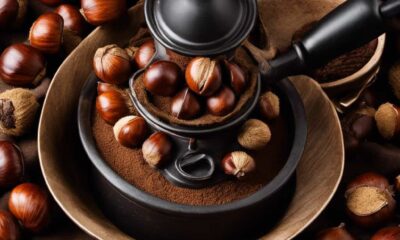
 Americano4 weeks ago
Americano4 weeks agoHow to Make Iced Americano With Instant Coffee
-

 Americano4 weeks ago
Americano4 weeks agoHow to Make Americano With Bialetti
-

 Americano4 weeks ago
Americano4 weeks agoHow to Make Dutch Bros Americano
-

 Americano6 days ago
Americano6 days agoHow to Make an Iced Americano With Nespresso
-

 Americano2 weeks ago
Americano2 weeks agoHow Many Shots of Espresso for 16 Oz Americano
-

 Turmeric Tea1 week ago
Turmeric Tea1 week agoTurmeric Saffron Tea






